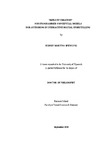‘IMPLICIT CREATION’ – NON-PROGRAMMER CONCEPTUAL MODELS FOR AUTHORING IN INTERACTIVE DIGITAL STORYTELLING
| dc.contributor.supervisor | Phippen, Andy Dr. | |
| dc.contributor.author | Spierling, Ulrike Martina | |
| dc.contributor.other | Plymouth Business School | en_US |
| dc.date.accessioned | 2012-09-21T09:31:03Z | |
| dc.date.available | 2012-09-21T09:31:03Z | |
| dc.date.issued | 2012 | |
| dc.identifier | 351336 | en_US |
| dc.identifier.uri | http://hdl.handle.net/10026.1/1195 | |
| dc.description.abstract |
Interactive Digital Storytelling (IDS) constitutes a research field that emerged from several areas of art, creation and computer science. It inquires technologies and possible artefacts that allow ‘highly-interactive’ experiences of digital worlds with compelling stories. However, the situation for story creators approaching ‘highly-interactive’ storytelling is complex. There is a gap between the available technology, which requires programming and prior knowledge in Artificial Intelligence, and established models of storytelling, which are too linear to have the potential to be highly interactive. This thesis reports on research that lays the ground for bridging this gap, leading to novel creation philosophies in future work. A design research process has been pursued, which centred on the suggestion of conceptual models, explaining a) process structures of interdisciplinary development, b) interactive story structures including the user of the interactive story system, and c) the positioning of human authors within semi-automated creative processes. By means of ‘implicit creation’, storytelling and modelling of simulated worlds are reconciled. The conceptual models are informed by exhaustive literature review in established neighbouring disciplines. These are a) creative principles in different storytelling domains, such as screenwriting, video game writing, role playing and improvisational theatre, b) narratological studies of story grammars and structures, and c) principles of designing interactive systems, in the areas of basic HCI design and models, discourse analysis in conversational systems, as well as game- and simulation design. In a case study of artefact building, the initial models have been put into practice, evaluated and extended. These artefacts are a) a conceived authoring tool (‘Scenejo’) for the creation of digital conversational stories, and b) the development of a serious game (‘The Killer Phrase Game’) as an application development. The study demonstrates how starting out from linear storytelling, iterative steps of ‘implicit creation’ can lead to more variability and interactivity in the designed interactive story. In the concrete case, the steps included abstraction of dialogues into conditional actions, and creating a dynamic world model of the conversation. This process and artefact can be used as a model illustrating non-programmer approaches to ‘implicit creation’ in a learning process. Research demonstrates that the field of Interactive Digital Storytelling still has to be further advanced until general creative principles can be fully established, which is a long-term endeavour, dependent upon environmental factors. It also requires further technological developments. The gap is not yet closed, but it can be better explained. The research results build groundwork for education of prospective authors. Concluding the thesis, IDS-specific creative principles have been proposed for evaluation in future work. | en_US |
| dc.language.iso | en | en_US |
| dc.publisher | University of Plymouth | en_US |
| dc.subject | Interactive storytelling | en_US |
| dc.subject | Digital storytelling | |
| dc.subject | Story modelling | |
| dc.subject | Authoring | |
| dc.subject | Narrative concepts | |
| dc.subject | Interactive media education | |
| dc.subject | Scenejo | |
| dc.subject | Implicit creation | |
| dc.title | ‘IMPLICIT CREATION’ – NON-PROGRAMMER CONCEPTUAL MODELS FOR AUTHORING IN INTERACTIVE DIGITAL STORYTELLING | en_US |
| dc.type | Thesis | |
| plymouth.version | Full version | en_US |
| dc.identifier.doi | http://dx.doi.org/10.24382/4362 | |
| dc.identifier.doi | http://dx.doi.org/10.24382/4362 |
Files in this item
This item appears in the following Collection(s)
-
01 Research Theses Main Collection
Research Theses Main


